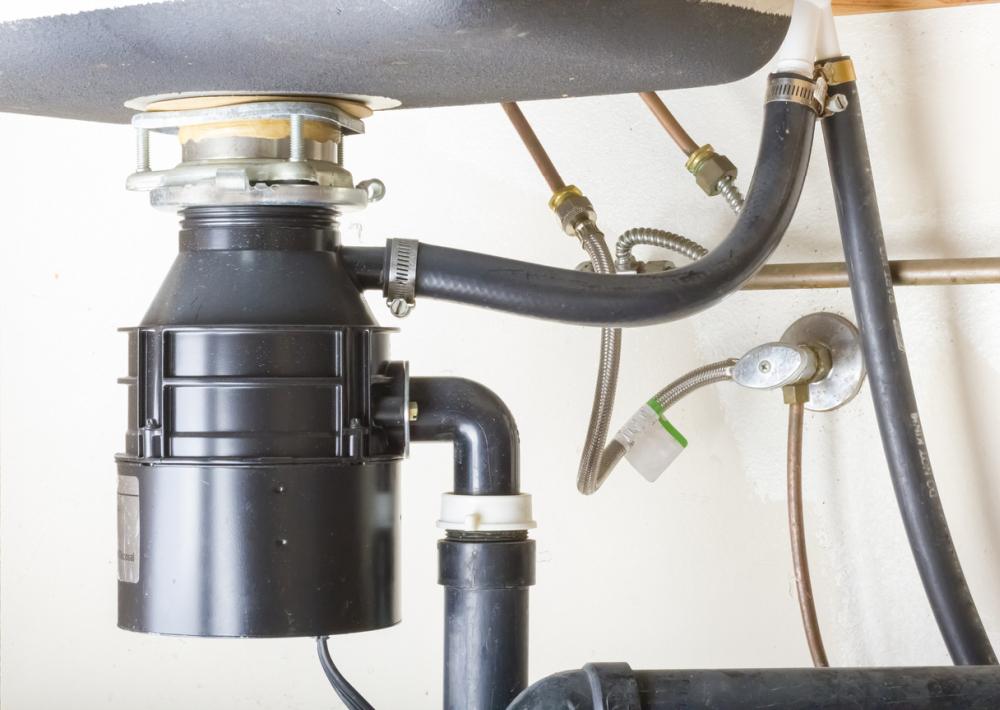When your garbage disposal isn’t working, there’s no need to panic – most of the time it’s an easy fix.

Learning how to fix your garbage disposal can keep you from making unnecessary repair calls. We’ll walk you through all the easy ways to fix a garage disposal that stopped working. If these don’t remedy the issue it’s time to call a repair service.
How to Fix Your Garbage Diposal: Try This First
Most garbage disposals have a reset button. If yours stops working, press the reset button and try again. If this doesn’t work, make sure the garbage disposal has power and is plugged in. You can also try resetting the breaker on your home’s electrical panel. If it still doesn’t work, try to unclog it.
To unclog a garbage disposal, insert a 1/4-inch hex wrench or Allen wrench into the hex-shaped hole on the bottom of the garbage disposal (underneath the sink.) Crank it a few times to clear the propeller.
Garbage Disposal Parts
To get a better idea of how to fix a garbage disposal, you need to find out how a garbage disposal works. When you turn on the disposal, a disc spins, pulling food into the grinding chamber. The impeller grinds food until it’s small enough to pass through pipes.
Read more : What Is a Wet and Dry Kitchen?
Each garbage disposal is a little different. Some have dishwasher attachments, while others are basic. These are the common parts of a garbage disposal:
- Stopper – the plug of the disposal.
- Flanges – to strengthen the position of the hopper.
- Hopper – the chamber where food is ground.
- Stopper Switch – controls the stopper.
- Shredder Ring – contains the impeller and helps to grind food.
- Impeller – pulls food down to be ground up.
- Drain Opening – houses water and food to be drained.
- Shredding Housing – holds the drain chamber and is the lower part of the hopper.
- Sink Drain – the drain that allows food to pass through to pipes.
- Power Supply – this will usually be a wall switch into the outlet to power the garbage disposal.
- Reset Button – resets the garbage disposal as the first reaction to troubleshooting problems.
Garbage Disposal Repair: Troubleshooting Common Problems

Here are some garbage disposal troubleshooting tips, and how to fix each problem.
Garbage Disposal Not Responding
An unresponsive garbage disposal isn’t getting any power. If you suspect this is the problem, check your home’s electrical panel. If you hit the reset switch, make sure the outlet has power. Unplug the garbage disposal and plug in something else.
Garbage Disposal Humming
When you hear a humming sound, your garbage disposal is jammed. Foreign objects (like chicken bones) are the most common cause of a garage disposal not working.
Unclog the device with a hex wrench at the bottom of the garbage disposal under the sink. Before you do anything, unplug the disposal. If you can’t clear the blockage with your hex wrench, you may need to use small tongs to clear the drain. Use a long pair of tongs and avoid placing your hand in the drain or disposal.
Sink Not Draining
If you’re sink isn’t draining, you have a plumbing problem rather than a garbage disposal issue. You might need to take the disposal out to fix the clogged pipe. For severe drainage issues, contact a plumber.
Leaking Garbage Disposal
When there’s a leak, look for water dripping from the pipes or base of your unit. If you’ve determined that water is leaking from the disposal, tighten loose areas, which many include screws in the disposal or the plumbing connections. If there are no loose areas to tighten, you may have a crack in disposal which requires replacement.
Garbage Disposal Not Grinding Well
Read more : Kitchen Table Polyamory Gives New Meaning to the Concept of ‘Chosen Family’
If your disposal isn’t grinding well, run extra water the next time you use it. Many people don’t use enough water when grinding their food, causing issues.
Tips To Prevent Garbage Disposal Problems
Preventing garbage disposal problems is better than fixing them. Here’s what to do:

Run Cold Water During Usage
Run cold or warm water while your disposal is running and for 15 seconds afterward to flush the drains. Failure to run water can cause the motor to burn and cause your drain to smell bad.
Don’t Overstuff the Disposal
Large food items can get stuck in your disposal. Toss large pieces of food in the trash or your compost bin.
If you have a lot of smaller food pieces to process, add them slowly rather than shoving everything in at once.
No Chemicals
Corrosive chemicals can harm the discharge pipe or discharge tube of your disposal. Never pour bleach or drain cleaner down the same drain trap as your disposal.
Source: https://gardencourte.com
Categories: Kitchens


